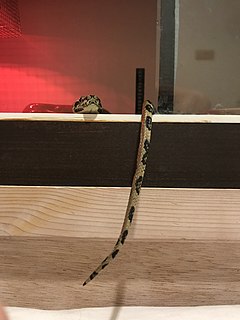Caudal luring

Caudal luring is a form of aggressive mimicry characterized by the waving or wriggling of the predator's tail to attract prey.[1] This movement attracts small animals who mistake the tail for a small worm or other small animal.[1] When the animal approaches to prey on the worm-like tail, the predator will strike.[1] This behavior has been recorded in snakes,[2] sharks,[3] and eels.[4]
Mimicry
The tail of a species may serve various functions, such as aggression, defense and feeding.[5] Caudal luring behavior was first recorded in 1878[6] and is an instance of aggressive mimicry.[7] Predators attract their prey by moving their caudal section to mimic a small animal, such as a worm, and attract prey animals.[1] The prey is intrigued by caudal movement and will investigate assuming it is their own prey, and the predator will strike.[5]
Species
Snakes
Caudal luring behavior is found in over 50 different snake species.[2] It is most common in boas, pythons, tropidophiids, colubrids and elapids of the genus Acanthophis, and the most evident in vipers and pit vipers, especially in rattlesnakes.[8][9][10] When the snake is foraging, it waits coiled up with its tail elevated and visible, wiggling around in a way that mimics a smaller animal and captures the attention of its prey.[1] Once the prey is in striking range, the snake attacks.[1] An immobile tail does not attract prey, confirming that it is the moving lure that tricks and attracts prey.[11] Caudal luring behavior is only elicited when prey are nearby.[11] Due to the tail resembling a writhing caterpillar and another worm-like insect larvae, the tail of the snake is often referred to as a vermiform.[2] Some species have developed elaborate lures to mimic a specific animal, such as the spider-tailed horned viper, which employs a highly modified tail to mimic a spider's form and locomotion.[12]
Of the snakes that practice the caudal luring behavior, 80% are juvenile.[13] The tails of juvenile snakes are typically conspicuously colored and fade to become more similar to the rest of the body with age.[1][14] This has been theorized to be an explanation for why caudal luring is most successful and prevalent in juveniles.[15] However, this explanation has been contested.[15] Experimental manipulation of Sistrurus miliarius’ tail color to make the tail match the rest of the juvenile's body revealed no significant difference in foraging success.[15] Another theory for juvenile success has been that their small tails are more effective lures compared to an adult's larger tail. Studies have confirmed that a smaller lure is more effective in attracting prey, as it is closer to the size of the worm-like prey.[11]
Sharks
Caudal luring also occurs in sharks, most common among
The tasselled wobbegong (
Eels
Caudal luring is suspected to occur in the family
Evolution
It has been suggested that caudal luring was involved in the evolution of the tail vibration rattle of rattlesnakes, a warning signal and a way of auditory communication, though this has been challenged.[18][19][20][5] Prey luring, in general, is confounded by false interpretation, as the wiggling of an appendage could have other behavioral meanings including aposematism, defense, or nervous release, and experimental evidence has been weak.[5][21][19]
Caudal luring is thought to have evolved from a caudally localized intention movement[19] (a behavior derived from locomotor movements). Essentially, the act of remaining stationary while sensing prey produces general nervous system excitation that gets released in the form of tail movements.[19] Caudal luring is not merely tail undulations, but must specifically be attractive to prey.[22] Caudal distraction is another behavior used by snakes, and the tail motions are similar to caudal luring.[22] The difference is in the snake's posture and especially in the nature and outcome of the behavior in reference to the encounter with prey.[22] Other caudal luring-like movements occur as warning signals and are induced by stressful circumstances.[5]
References
- ^ JSTOR 3891463.
- ^ PMID 23976823.
- ^ S2CID 205226057.
- ^ .
- ^ JSTOR 1565399.
- ISSN 0173-5373.
- .
- JSTOR 1564391.
- JSTOR 1563366.
- PMID 6784280.
- ^ .
- doi:10.1163/15685381-00002997. Footage of the spider-tailed horned viper using its tail to lure a migrating bird featured in the Asia episode of the BBC series Seven Worlds, One Planet narrated by David Attenborough.
- JSTOR 1446315.
- PMID 6784280.
- ^ S2CID 85107608.
- ^ OCLC 46449134.
- ISSN 0722-4028.
- S2CID 53177551.
- ^ S2CID 53177551.
- JSTOR 1447554.
- ISSN 0024-4066.
- ^ JSTOR 41713137.

